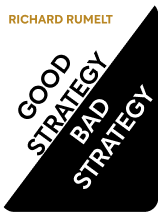

This article is an excerpt from the Shortform book guide to "Good Strategy Bad Strategy" by Richard Rumelt. Shortform has the world's best summaries and analyses of books you should be reading.
Like this article? Sign up for a free trial here .
What is organizational inertia? How does inertia manifest within an enterprise and how can you overcome it as a business?
In simple terms, organizational inertia is when an enterprise becomes “set in its own ways.” According to Richard P. Rumelt, the author of Good Strategy, Bad Strategy, inertia generally falls into one of three categories: 1) inertia of habits, 2) cultural inertia, and 3) indirect inertia.
Keep reading to learn about organizational inertia, its types, and ways to overcome it.
Organizational Inertia Stops You From Making Needed Changes
If your organization suffers from inertia, it is less able to adapt to competitive changes. There are three types of organizational inertia:
- Inertia of habits
- Cultural inertia
- Indirect inertia
Recognizing which category fits your own particular inertia can help you properly address it. Recognizing which fits a competitor’s inertia can help you exploit it.
1) Inertia of Habits
Inertia of habits and policies can prevent a company from quickly reacting to competitive threats.
Any sizable organization that’s been around for at least a few years relies on a set of routines and habits to guide its everyday operations, such as how it buys and markets products, pursues new business, hires talent, designs facilities, and outlines plans. This can benefit a company greatly; an organization does not have the time or resources to reinvent the wheel at every decision, and its ability to operate successfully is supported by layers of accumulated knowledge and expertise. However, these habits can be detrimental to a company when they preserve old ways of doing things that may not be appropriate when changes come along—for example, continuing to charge certain surcharges when your competitors have dropped the practice.
To change inertia that’s linked to habits and routines, a company needs to get its top management on board with the new way of thinking. Sometimes, top management sees the value in the changes and the company can be turned around quickly. Other times, managers who cannot adjust will need to be replaced, often with people from other firms who already use the new methods.
Case Study: U.S. Airline Industry
The deregulation of the U.S. airline industry in 1978 illustrates the effects of inertia of habits. Airlines freed from governmental regulation had trouble adjusting to the new competitive landscape in two ways.
First, they misunderstood how price pressures would change. When prices were set by the government, expensive, profitable long-haul routes subsidized cheap, loss-producing short-haul routes. After deregulation, all the major airlines assumed that those dynamics would continue. However, this did not prove to be the case: Customers wanted lower fares for long routes, but they were more willing to pay higher fares for short routes.
Second, they misjudged how capacity constraints would change. Before deregulation, airlines would invest in new equipment and bigger planes without considering whether or not consumer demand would support it because they knew the government would set prices that would cover their debts. Therefore, with no incentive not to increase the sizes of aircraft, the industry ended up with a significant oversupply of seats. Their rule of thumb became, “Equip when the competition equips.” After deregulation, this habit led to massive overcapacity.
The major airlines, operating on habits and procedures developed for a previous era, were unable to stay profitable. In 1981, the carriers who had continued to bet on a strategy of expensive long-haul routes (United, American, and Eastern) together lost 240 million dollars, while carriers who’d pivoted toward making short-haul routes more pricey (including Delta, Frontier, and USAir) turned a profit.
2) Cultural Inertia
Inertia of culture can also stop a company from reacting quickly to competitive challenges. “Culture” describes the stable, change-resistant elements of social behavior. Cultural inertia often shows up in overly complex processes and routines that a company has incorporated into its daily operations, such as managers who make virtually all decisions by committee, setting up endless meetings instead of delegating decision-making power to individuals.
Organizational culture can prove very hard to change. When presented with strategy solutions that deviate significantly from previous modes of thinking, executives often respond defensively, preferring to double down on existing beliefs and attitudes that drive the company, even if those norms are ultimately harmful.
For example, in the 1980s, AT&T knew it needed to enter the computer communications arena. As the owner of Bell Labs—developers of Unix, the operating system that today underpins Linux and Apple’s Mac OS X—the company seemed to have the resources needed to become a key player. However, its executives assumed that all problems would have complex solutions, a false belief that stemmed from their experiences running the company up to that point. Thus, when tasked with creating a computer network, AT&T ignored simple solutions presented to them and instead opted for a long, expensive, complex solution from Bell Labs. Because they were unable to see past their traditional beliefs in complexity, more nimble competitors were able to leapfrog them.
To break cultural inertia, a company must simplify the complex processes and routines that their workforce has become accustomed to. Such complexity usually hides waste and inefficiency. This means reducing administrative overhead, closing down or outsourcing non-essential operations, and culling unnecessary initiatives. Sometimes, an organization will need to fragment its departments to cut off harmful modes of thinking that cross operating units. Additionally, top management may need to be replaced in order to establish a new set of values and norms from the top down.
3) Indirect Inertia
At times, inertia comes from a company’s customers instead of from the company itself. If a company’s customers have not yet changed their buying habits in response to an industry change, the company might resist changing because it doesn’t want to let go of those sales that they’ve come to rely on. This kind of indirect inertia has the same result as when a company has inertia internally, because it prevents a company from adjusting to the changing landscape. A company suffering from indirect inertia is vulnerable to competitors because its rivals sense that they can make a play for the company’s business without the company responding.
An example of this was the Philadelphia Savings Fund Society (PSFS), a bank that continued to offer savings accounts with five-percent interest returns even when, in 1980, the prime interest rate set by the government hit 20 percent and other banks started to offer savings accounts with much higher rates as a result. PSFS chose not to follow its competitors’ leads because it reasoned that its average depositor was retired, unsophisticated, and unaware of the higher rates offered by other banks, and therefore the bank could get away with keeping interest rates low simply because their customers had inertia. This left it open to competitors, who could easily poach its customers without the bank mounting a meaningful response.
Indirect inertia can be resolved when an organization finally decides to endure short-term loss for long-term gain. If this happens quickly enough, a company might be able to recapture some of the opportunities it had passed up. If it delays making this change for too long, though, it may allow a competitor to establish dominance in the new landscape and may not be able to win back the new business.

———End of Preview———
Like what you just read? Read the rest of the world's best book summary and analysis of Richard Rumelt's "Good Strategy Bad Strategy" at Shortform .
Here's what you'll find in our full Good Strategy Bad Strategy summary :
- The essential components of good strategy and the faulty thinking behind bad strategy
- Specific and measurable techniques for designing a focused strategy for success
- How to overcome challenges and gain a competitive edge






